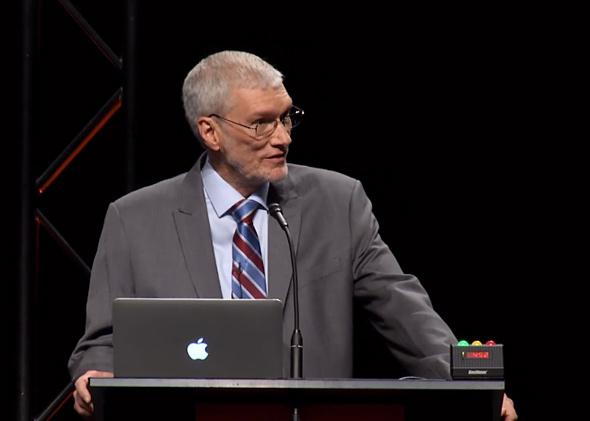Tuesday night, Bill Nye, the Science Guy, debated Ken Ham, the president of Answers in Genesis, at the Creation Museum in Kentucky. The debate (full video here) was ostensibly about whether young-Earth creationism—belief in the literal truth of Genesis, including a 6,000-year-old Earth—is a viable scientific theory. Nye won that debate. Creationism (as Slate’s Phil Plait has explained at length) is false.
But Nye came with a bigger agenda. He wanted to convince the viewing audience that creationism was a threat to science, technology, and prosperity. At this, he failed. Creationism, as presented by Ham and his colleagues, is a compartmentalized myth. It doesn’t prevent its adherents from functioning as ordinary people or as scientists.
I’m not saying creationism might be true. It’s incoherent and discredited. Nye presented plenty of evidence—ice samples, ancient trees, sediment deposits—that can’t be squared with a young Earth. To defend Genesis literally, you’d have to explain why no fossil bed has yielded fossils out of the order predicted by evolution (more-evolved animals buried in higher layers, less-evolved animals in lower layers). You’d have to explain how 16 million species evolved from 7,000 ark-borne prototypes in 4,000 years—11 new species per day. You’d have to explain how kangaroos got from the Middle East to Australia across the water and without leaving traces. You’d have to explain how Noah, his three sons, and their wives defied the laws of engineering by building a wooden boat big enough to hold so many animals and stay afloat.
Even on Ham’s terms, the story falls apart. To cast doubt on evolution, he pointed to discrepancies among various methods of estimating the age of rocks or fossils. But all of the estimates precluded a 6,000- or 10,000-year-old Earth. He said you can’t prove what happened in the past because you can’t see it. Yet he accepted astronomy, which, given interstellar distances and the speed of light, consists of seeing the past. He suggested that today’s laws of biology didn’t become operative until perhaps 5,000 years ago. Nye dismissed that belief, correctly, as “magical.”
But that magical premise is what keeps Ham sane. It lets him cling to a mythical past while accepting today’s realities. The core of Ham’s worldview, which Nye attacked again and again, is a distinction between “origins or historical science” (the fictional stuff) and “experimental or observational science” (the real stuff). “Bill and I all have the same observational science,” said Ham. He spoke with perfectly modern delight about satellites, mobile phones, and vaccines.
Ham presented videos from several scientists who espoused young-Earth creationism. One said he had invented the MRI scanner. Another said he had designed major components of spacecraft launched by NASA and the European Space Agency. If the spacecraft guy had botched his work, said Ham, you’d have heard about it. That’s true. In fact, it’s a perfectly scientific way of testing the perils of creationism. Can creationists function in science and technology? Manifestly, some can.
From the standpoint of scientific literacy, it’s galling to listen to absurdities about the distant past. But what matters in daily life isn’t whether you believe humans and apes evolved from a common ancestor. What matters is whether you’ll agree not to use antibiotics for your kid’s sinus infection after your doctor explains how germs, under the selective pressure of these drugs, evolve resistance. At one point, Ham showed a clip of Nye telling Larry King:
Apparently, people with these deeply held religious beliefs, they embrace that whole literal interpretation of the Bible, as written in English, as a worldview. And at the same time, they accept aspirin, antibiotic drugs, airplanes. But they’re able to hold these two worldviews. And this is a mystery.
Ham replied that it wasn’t a mystery. He acknowledged his split personality: “Ken Ham the Observational Science Bloke” versus “Ken Ham the Historical Science Bloke.” As an observational scientist, he demonstrated his openness to evidence. Yes, he said, continental plates are shifting. Yes, the universe is expanding.
The most intriguing part of the debate was Ham’s discussion of “kinds.” This is a creationist way of explaining visible evolution. According to Ham, finches and dogs have evolved, but finches have always been finches, and dogs have always been dogs. This boundary—evolution within kinds, but not evolution from one kind to another—is supposed to protect the myths of creation and the ark. But the boundary turns out to be flexible. To reduce the animals on the ark to a manageable cargo, Ham’s associates at Answers in Genesis have rationalized the number of “kinds” down to fewer than 1,000. This revision means that God did less of the work of diversification than originally supposed, so post-flood evolution had to do more. In effect, it’s creeping Darwinism.
Nye portrayed creationism as a cancer. Each time he spoke, he closed with the same warning: Creationism threatens technology, innovation, and prosperity. He insisted that you can’t do good science or run a successful society while maintaining a distinction between real, experimental science and mythical “historical science.” At one point, he showed a satellite image of the National Zoo in Washington, D.C. “That capability,” he said of the satellite, “comes from our fundamental understanding of gravity, of material science, of physics and life science.”
Actually, no. It doesn’t. You can be a perfectly good satellite engineer while believing total nonsense about the origins of life. That doesn’t mean we should teach creationism in schools or pretend it’s a scientific theory. But it does mean we can live with it as a compartmentalized fetish. Believe whatever you want to about monkeys, Noah, and the Garden of Eden. Just don’t let it mess with your day job.
